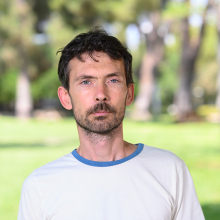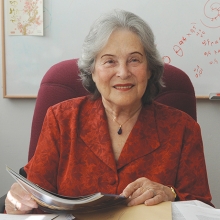The birth of a new carbon
Dr. Elena Meirzadeh
New scientists

Dr. Elena Meirzadeh
Dr. Elena Meirzadeh, who joined the Department of Molecular Chemistry and Materials Science as a principal investigator in the summer of 2023 after a postdoctoral fellowship at Columbia University, describes her work as “the interface between synthetic chemistry and materials science.”
She is delighted to be back at the Weizmann Institute, where she earned both her MSc and PhD degrees in chemistry and materials science. Her PhD thesis, completed under the supervision of Prof. Meir Lahav and Prof. Igor Lubomirsky (in what was then called the Department of Materials and Interfaces), investigated the interface of materials and how defects affect their properties.
As part of her doctoral research, she used dielectric measurements to detect small deviations from symmetry in crystals. The sensitive measurement technique she developed has expanded scientists’ ability to understand crystal structure, function, and different growth mechanisms.
Dr. Meirzadeh then spent one year as a postdoctoral researcher under the supervision of Profs. Lubomirsky and Lahav, studying the interplay between pyroelectricity and the ice nucleation of supercool water.
“The great thing about solid-state synthesis is that you can grow large, high-quality crystals. It allows us to determine their structure, create devices from these materials, and measure their characteristics. Solid-state synthesis allows you to take materials from fundamental science and create next-generation technologies,” she explains.
Exploring properties in 2D
With the support of the prestigious Israel National Postdoctoral Award for Advancing Women in Science, Dr. Meirzadeh was able to work as a research fellow in the lab of Prof. Xavier Roy in the Department of Chemistry at New York’s Columbia University.
Her work in the Roy group focused on the synthesis and characterization of functional two-dimensional materials (materials that respond to external stimuli, also known
as smart materials). She ended her postdoc by making a splash in the chemistry community, having discovered a new form of carbon that she named “graphullerene.”
An article introducing graphullerene was published in Nature in March 2023, with Dr. Meirzadeh as the first and corresponding author.
What makes the newly identified material special? Graphullerene is a hybrid of graphene and fullerene—organic carbon molecules—whose crystals can be peeled into extremely thin, two-dimensional sheets one-molecule thick. The 2D sheets allow scientists to explore different properties of the material, such as superconductivity.
The thing about semiconductors
For years, she explains, scientists tried to create bonds between fullerenes, which are ball-shaped super-atoms, but were unable to grow large single crystals of such materials. Dr. Meirzadeh solved this through a form of organometallic chemistry at high temperatures, taking fullerenes and heating them to 500-600 degrees in the presence of alkali metals.
The method of synthesis at elevated temperatures allowed her and her colleagues to create single crystals of the new material and determine its crystal structure.
“We were able to see exactly which atom is attached to what and assess their characteristics in a way that ensured there were no defects or impurities,” she explains.
Now that she has discovered graphullerene, she plans to start her career at Weizmann by “playing with it.”
“Now it’s been born, I need to see how it walks, how it dances, how it sings. Add all kinds of impurities to it, put it under different conditions, and look for interesting characteristics. It’s a semiconductor, and what’s nice about a semiconductor is that its physical properties change as a function of impurities,” she says.
Semiconductors, a hot topic in technology, are pure elements or compounds that have an electrical conductivity between conductors (usually metals) and nonconductors, such as most ceramics.
Appropriately enough for a chemist whose work is part of the scientific tradition of Institute founder Dr. Chaim Weizmann, Dr. Meirzadeh’s first home laboratory at the Institute will be in the historic Sieff Building.
Not one to waste time, she is already collaborating with Prof. Leeor Kronik, from the Department of Molecular Chemistry and Materials Science, with whom she worked during her PhD. “He did theoretical calculations that helped us explain qualities of the material and also might help steer us in new directions.”
There are other Weizmann scientists with whom she is also eager to collaborate. “I know that if I need something, I can knock on someone’s door and they will give their heart and soul,” she says.
Even as a student, Dr. Meirzadeh always dreamed of a career at the Weizmann Institute. “I love my department. I was really, really happy to come back. It was a dream come true. When I talk about the Institute, my eyes light up. It’s a little piece of heaven on earth. You know that they have your back,” she says.
Education and select awards
-
BSc, Hebrew University of Jerusalem (2011)
-
MSc (2013) and PhD (2017), Weizmann Institute of Science
-
Postdoc, Columbia University, New York (2018-2022)
-
Lodovico Prize for most dynamic student from the International School of Crystallography in Italy (2015); Israel Vacuum Society Female Scientist Award (2016); Israel Chemical Society-Uri Golik Prize for an Excellent Graduate Student (2018); Dimitris N. Chorafas Prize (2018); Rothschild Postdoctoral Fellowship (2018); Israel National Postdoctoral Award Program for Advancing Women in Science (2018); Women’s Postdoctoral Career Development Award in Science (2022); Foresight Fellowship (2023); Azrieli Early Career Faculty Fellowship (2023); Finalist, Blavatnik Regional Award for Young Scientists (2023)
-
Named on Forbes Israel’s “30 Under 30” list (2020)








